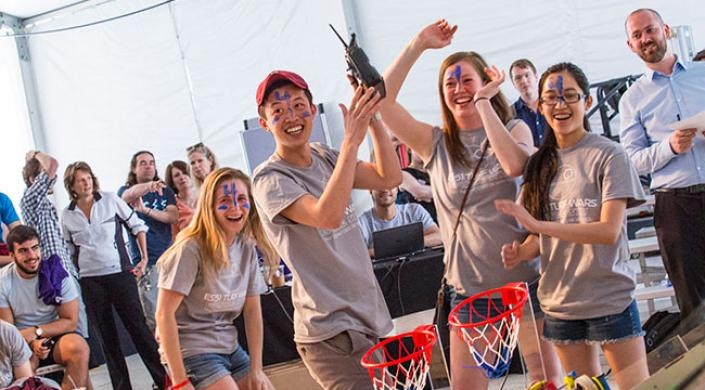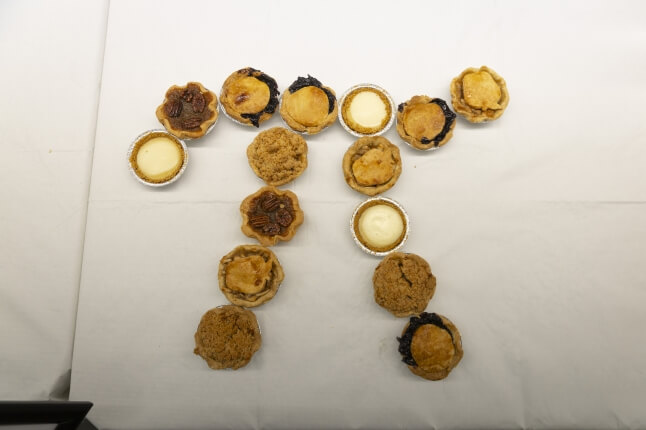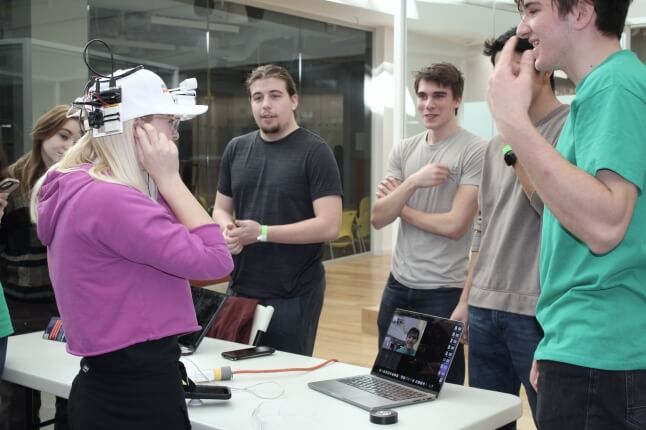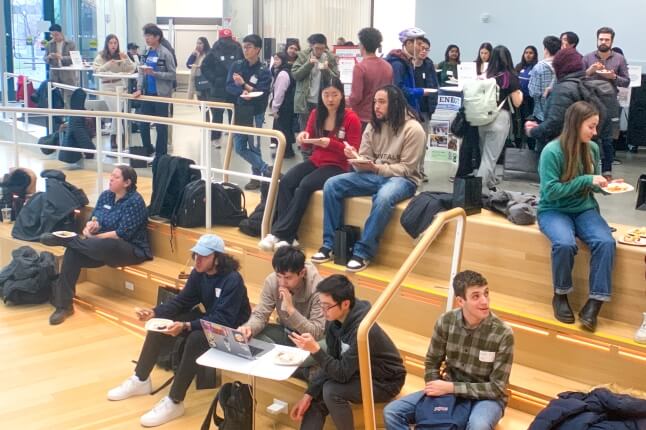News
SLIDESHOW: Students from ES51, Computer-Aided Machine Design, put their remote-controlled ATVs to the test during a claw-to-shovel competition for points on a challenging obstacle course. (photo by Eliza Grinnell/Harvard SEAS)
June 2014
By isolating mechanical and biological variables one by one in vitro, a team of researchers led by Prof. David Mooney, identified a possible mechanism by which normal cells turn malignant in mammary epithelial tissues, the tissues frequently involved in breast cancer.
After two years of effort, researchers led by Prof. Donhee Ham successfully measured the collective mass of ‘massless’ electrons in motion in graphene. Graphene is a one-atom-thick carbon sheet that has taken the world of physics by storm, in part because its electrons behave as massless particles. The research could provide a basis for the creation of miniaturized circuits with tiny, graphene-based components.
Greg Morrisett was among five members of the Harvard faculty who were appointed Harvard College Professors, recognizing excellence in undergraduate teaching.
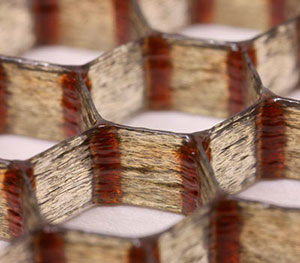 Translucent hexagonal honeycomb printed using the baseline epoxy ink with carbon fibers added for visualization. (Image courtesy of Brett G. Compton, Harvard University.)
Translucent hexagonal honeycomb printed using the baseline epoxy ink with carbon fibers added for visualization. (Image courtesy of Brett G. Compton, Harvard University.)
Led by Prof. David Mooney, a research team loaded a biocompatible hydrogel with a chemotherapy drug and used ultrasound to trigger the gel to release “on demand” drug bursts. The technique provides an innovative way to noninvasively administer drugs with a far greater level of control than was possible before.
Harvard engineers led by Prof. Jennifer Lewis used new resin inks and 3D printing to develop cellular composite materials of unprecedented light weight and stiffness. Because of their mechanical properties and the fine-scale control of fabrication, these new materials mimic and improve on balsa, and even the best commercial 3D-printed polymers and polymer composites available.
July 2014
Prof. Roger Brockett, a pioneer in control systems theory, founder of the Harvard Robotics Laboratory, and a 45-year member of the Harvard faculty, was recognized with the American Automatic Control Council’s 2014 John R. Ragazzini Education Award “for inspirational mentorship of generations of graduate students who have participated in defining the field of control engineering.”
Prof. Cynthia Friend was awarded a grant from the U.S. Department of Energy’s Basic Energy Sciences’ Energy Frontier Research Centers program to develop new methods to reduce energy consumption in the production of industrial chemicals. The sector now accounts for an astounding 25 percent of the world’s energy consumption.
Undergrads working in Harvard labs through the SEAS Research Experience for Undergraduates program conducted three days of science demonstrations and experiments in the Boston Public Schools. They reached more than 400 students in grades three through five and, in the process, provided a unique learning opportunity for local kids.
Boosting computer performance by a factor of a thousand—and finding ways to make that power readily accessible to the scientific community—is a formidable research challenge. The Summer 2014 issue of Topics explored how Harvard researchers are pushing the limits of high-performance computing power to achieve new breakthroughs in science and engineering.
SEAS deployed a new online visualization tool designed to dynamically illustrate the myriad connections between faculty, academic programs, and research and teaching areas. The tool was created by Rebecca Mazur, SEAS web developer, as her capstone project as a student in CS 171, the visualization course taught by Prof. Hanspeter Pfister.
August 2014
A multi-institutional team of engineers led by Prof. Donhee Ham created a portable device for nuclear magnetic resonance (NMR) spectroscopy, one of the most powerful analytical tools to determine molecular structures at atomic resolution. Their device represents the smallest device that can presently perform multidimensional NMR spectroscopy
Prof. James Rice received the Theodore von Karman Medal of the American Society of Civil Engineers, presented annually to one person “in recognition of distinguished achievements in engineering mechanics.” A 33-year member of the Harvard faculty, Rice has devoted recent decades of his career to studying the mechanics and physics of Earth and environmental processes.
Prof. Robert Wood and a team of engineers created the first robot that builds itself and performs a function without human intervention. The robot can assemble itself into a complex shape in four minutes and then crawl away. The demonstration shows the potential to quickly and cheaply build sophisticated machines that interact with the environment, and to automate much of the design and assembly process.
For the third summer, SEAS offered a free Science & Cooking program for kids, taught by Harvard researchers and local award-winning chefs. Students in the 4th through 6th grade from Cambridge and the surrounding communities learned about cooking techniques and how to connect food and cooking with science and math concepts.
Led by Prof. David Weitz, a team of applied physicists and cell biologists demonstrated a way to quantify the aggregate forces felt by particles and organelles in the cell, raising a host of new questions about cellular dynamics and providing a robust new tool for future investigations. The research could be critical for research on development, cancer biology, and metabolism.
The first is self-organizing swarm of 1,024 little robots was created in the lab of Prof. Radhika Nagpal. Drawing inspiration from nature, the kilobots demonstrate how complexity can arise from very simple behaviors performed en masse, and represent a significant milestone in the development of collective artificial intelligence.
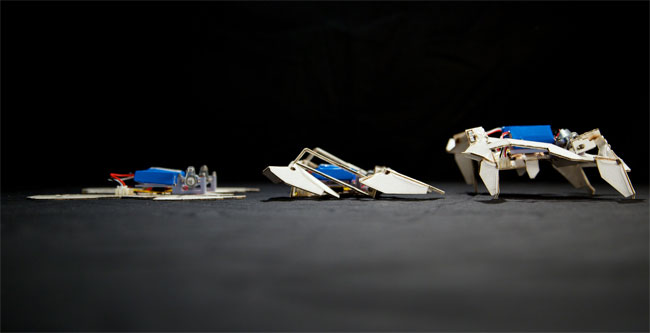
Professor Rob Wood and a team of engineers used little more than paper and Shrinky dinks™ to build a robot that assembles itself into a complex shape in four minutes flat, and crawls away without any human intervention. (photo by Seth Kroll/Wyss Institute at Harvard University)
September 2014
Prof. Jennifer Lewis created a new course, “Introduction to Biomaterials” (BE 191). The foundational course in biomedical engineering is designed for undergraduates who want to focus on medical devices, drug delivery, or tissue engineering. It prepares students to contribute to university research, pursue summer internships, or take an idea conceived in the classroom to the next stage of development.
Prof. Conor Walsh was awarded a $2.9 million follow-on contract from the Defense Advanced Research Projects Agency to further develop a biologically inspired smart suit. The Soft Exosuit is intended to be worn comfortably under clothing and could enable soldiers to walk longer distances, keep fatigue at bay, and minimize the risk of injury when carrying heavy loads.
Researchers in the lab of Prof Robert Wood produced the first untethered soft robot—a quadruped that can stand up and walk away from its designers. The team was able to scale up earlier soft-robot designs, enabling a single robot to carry on its back all the equipment it needs to operate—microcompressors, control systems, and batteries.
A team led by Prof. Shriram Ramanathan engineered a quantum material called a correlated oxide that performs comparably with the best silicon switches. The researchers achieved a reversible change in electrical resistance of eight orders of magnitude, a result they called “colossal.”
A novel protein engineering system developed by a team led by Prof. Neel Joshi could become tomorrow’s living foundries for the large-scale production of biomaterials that can be programmed to provide functions not possible with existing materials.
Several SEAS researchers unveiled the Soft Robotics Toolkit, an online treasure trove of downloadable, open-source plans, how-to videos, and case studies to assist users in the design, fabrication, modeling, characterization, and control of soft robotic devices. It provides researchers with a level of detail not typically found in academic research papers, including 3D models, bills of materials, raw experimental data, multimedia step-by-step tutorials, and case studies of various soft robot designs.
Using simple hydrodynamics, a team of researchers led by Prof. L. Mahadevan showed that a handful of principles govern how virtually every animal — from the tiniest fish, to birds, to gigantic whales — propel themselves though water.
Prof. Kit Parker developed a human airway muscle-on-a-chip that accurately mimics the way smooth muscle contracts in the human airway, under normal circumstances and when exposed to asthma triggers. The work, which offers a window into the cellular and even subcellular responses within the tissue during an asthmatic event, could be used to test new drugs.
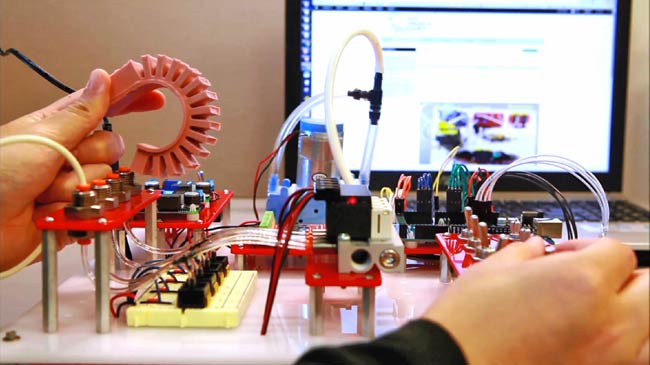
The Soft Robotics Toolkit is an online treasure trove of resources to assist users in the design, fabrication, modeling, characterization, and control of soft robotic devices. (Photo by Eliza Grinnell, Harvard SEAS.)
October 2014
The White House announced that Dean Cherry Murray would receive the National Medal of Technology and Innovation, the United States' highest honors for achievement and leadership in the advancement of science and technology. Recipients are leaders who have made lasting contributions to America’s competitiveness and quality of life and who have helped strengthen the nation’s technological workforce.
Prof. Hanspeter Pfister teamed up with colleagues at Harvard Medical School’s Center for Biomedical Informatics to produce StratomeX, software that helps researchers distinguish subtypes of cancer by crunching through the massive data sets gathered as part of the Cancer Genome Atlas, a National Institutes of Health–funded initiative. Identifying distinct cancer subtypes can lead to more effective, personalized treatments.
During work trips spanning two and half years, students in the Harvard chapter of Engineers Without Borders rehabilitated and improved a potable water system in Pinalito, a rural town in the Dominican Republic. On their most recent visit, the students successfully worked with the community to upgrade the water quality and distribution system.
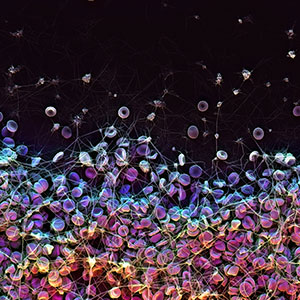 This SEM image shows how red blood cells coagulate to form a blood clot. (image by James Weaver/Wyss Institute at Harvard University)
This SEM image shows how red blood cells coagulate to form a blood clot. (image by James Weaver/Wyss Institute at Harvard University)
A team led by Prof. Donald Ingber developed a new surface coating for medical devices that repelled blood from more than 20 medically relevant substrates the team tested—made of plastic, glass, and metal—and also suppressed biofilm formation. The idea for the coating evolved from SLIPS, a pioneering surface technology developed by Prof. Joanna Aizenberg.
Cherry A. Murray announced her decision to step down at the end of 2014 as Dean of SEAS, a post she held for five years during a period marked by dramatic growth in the enrollment and visibility of the school.
Members of the Optical Society, a leading professional organization for those who study the science of light, elected Prof. Eric Mazur to serve as the group’s vice president. He will serve one year as vice president, followed by one year as president-elect, and become president in 2017.
November 2014
For her capstone design project, Katherine (Katie) Cagen '14 invented a device she calls Ferrotouch, a tactile display technology that uses electromagnetically actuated materials to create a sort of "refreshable Braille." The recent alumna was a finalist in the national Collegiate Inventors Competition, which recognizes undergraduate and graduate students who are committed to research, discovery, and invention with the goal of changing the world for the better. The competition honors and supports inventions that have a good chance of receiving patent protection and creating economic value.
Stating that the computer science faculty at Harvard today is “small, but excellent” and “already punches above its weight,” former Microsoft CEO Steve Ballmer AB ’77 announced a gift to expand the size of the CS faculty by 50 percent.
A team of researchers led by Prof. David Keith outlined how a small-scale “stratospheric perturbation experiment” could work. By proposing, in detail, a way to take the science of geoengineering to the skies, they sought to stimulate serious discussion of the practice by policymakers and scientists. Ultimately, they argued, informed decisions on climate policy will need to rely on the best information available from controlled and cautious field experiments.
For her pioneering work in the field of microscale 3D printing, and for advancing the development of artificial organs, flexible electronics, and special new materials, Prof. Jennifer Lewis was named among Foreign Policy magazine's "100 Leading Global Thinkers of 2014."
Computer science concentrator Ruth Fong '15, was one of two students at Harvard, and 32 nationally, to be named Rhodes Scholars for 2015. At Oxford, she intends to pursue both the M.Sc. in Mathematics and Foundations in Computer Science, and the M.Sc. in Computer Science.
Prof. Amir Yacoby was named a Fellow of the American Association for the Advancement of Science. Election as a Fellow is an honor bestowed upon AAAS members by their peers.
FAS Dean Michael Smith announced the appointment of Harry Lewis as Interim Dean of SEAS effective January 1, 2015.
December 2014
Researchers led by Prof. David Mooney showed that a non-surgical injection of programmable biomaterial that spontaneously assembles in vivo into a 3D structure could fight and even help prevent cancer and infectious diseases such as HIV.
SEAS honored computer pioneer Grace Murray Hopper on her birthday with a program featuring journalist Walter Isaacson ’74, and a panel of women computer scientists.
Hundreds of community and family members from Cambridge, Boston, and the surrounding area attending the annual SEAS holiday lecture learned how science and scientific ideas can help us understand so many things about the world.
Now the Harvard class with the largest enrollment, CS50 culminated at the end of the term with the CS50 Fair, an opportunity for students taking the introductory computer science course to show off their final projects to the wider community—and for others to see what programming is all about.
A team including scientists from nearly a dozen universities and agencies and led by Prof. Steve Wofsy was awarded a NASA grant that will support an airborne, globe-spanning study of the Earth’s atmosphere. The research will establish how air pollution from human activities reacts with greenhouse gases and develop the scientific foundation for near-term strategies to mitigate climate change.
Prof. Radhika Nagpal was named among Nature’s 10, the ten scientists and engineers who “made a difference” in 2014.
A technique developed in Prof. Federico Capasso’s lab coats a metallic object with an extremely thin layer of semiconductor, just a few nanometers thick. Although the semiconductor is a steely gray color, the object ends up shining in vibrant hues. That's because the coating exploits interference effects in the thin films. Carefully tuned in the laboratory, the coatings can produce vivid colors using the same two metals, applied with only a few atoms' difference in thickness.
January 2015
Vice Provost and SEAS Prof. Richard McCullough was one of three Harvard faculty named a fellow of the National Academy of Inventors.
The Gary Michelson Found Animals Foundation awarded Prof. David Mooney a three-year grant to pursue development of vaccine technology that would provide a nonsurgical method for spaying and neutering dogs and cats.
Profs. Michael Mitzenmacher and Stuart Shieber, were among 47 leading computer scientists named 2014 Fellows of the Association for Computing Machinery.
 Researchers estimate that $90 million worth of natural gas escapes the Boston region’s delivery system each year.
Researchers estimate that $90 million worth of natural gas escapes the Boston region’s delivery system each year.
A study by Prof. Steven Wofsy of the aging system of underground pipes and tanks that delivers natural gas to Boston-area households and businesses calculated that each year about 15 billion cubic feet of natural gas, worth some $90 million, escapes the region’s delivery system, with adverse economic, public health, and environmental consequences.
Hundreds of privacy experts, computer scientists, mathematicians, lawyers, policy scholars, and interested citizens gathered for the fourth annual Symposium on the Future of Computation in Science and Engineering. The daylong symposium addressed “Privacy in a Networked World” and included an appearance (from Moscow via Google Hangouts) by Edward Snowden, the former National Security Agency (NSA) systems administrator who leaked classified records of NSA surveillance efforts.
February 2015
A team including Prof. Jennifer Lewis and colleagues from Lawrence Livermore National Laboratory demonstrated a novel class of materials that enable a safer, cheaper, and more energy-efficient process for removing greenhouse gas from power plant emissions. The approach could be an important advance in carbon capture and sequestration.
Building on previous work on super-slippery coatings, Prof. Joanna Aizenberg developed a powerful, long-lasting repellent surface technology called liquid-infused polymers that can be used with medical materials to prevent infections caused by biofilms.
The Harvard-China Partnership for Low-Carbon Energy Future, led by Prof. Michael McElroy, was one of seven research projects aimed at confronting the challenge of climate change that were awarded grants in the inaugural year of President Drew Faust’s Climate Change Solutions Fund.
A group of Harvard and Brazilian students spent winter break in São Paulo participating in the sixth annual collaborative field course between Harvard and the University of São Paulo. The 10-day program included visits to the headquarters for Santander Bank and the Tower Bridge building, both of which incorporate green design principles, as well as a facility where waste water is recycled for industrial purposes.
A new type of lens created in the lab of Prof. Federico Capasso was a major leap forward in the field of flat photonics. The device is an ultra-thin, completely flat optical component made of a glass substrate and tiny, light-concentrating silicon antennas. Light shining on it bends instantaneously, rather than gradually, while passing through. The bending effects can be designed in advance, by an algorithm, and fine-tuned to fit almost any purpose.
Two SEAS faculty members were named 2015 Alfred P. Sloan Research Fellows: Ryan Adams to support his research in the field of machine learning; and applied mathematician Ariel Amir, to support research on condensed matter and biophysics.
Along with colleagues at MIT, researchers in Prof. Joanna Aizenberg’s lab identified two optical structures within the limpet’s shell that produce its blue-striped appearance. It represents the first evidence of an organism using mineralized structural components to produce optical displays.
March 2015
A team led by Prof. Joanna Aizenberg developed an entirely new, highly versatile mechanism for controlling passage of materials through micropores, using fluid to modulate their opening and closing. The ability to selectively transport or extract materials is valuable for uses such as separating components of oil, gas and wastewater, for filtering blood and fluid samples, and broadly for 3D printing and microfluidic devices.
Prof. Ralph Mitchell was called in to help Chilean archeologists solve the mystery of why 5,000-year-old mummies were starting to visibly degrade at an alarming rate. His research determined that climate change may be part of the answer.
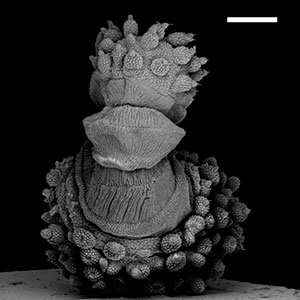 Accordion-like features on the velvet worm's papilla are key to its wide-spraying slime attack, a new study has found.
Accordion-like features on the velvet worm's papilla are key to its wide-spraying slime attack, a new study has found.
Applying new insights from anatomy, mathematics, experimental physics, and fluid dynamics, a team that began its work in the lab of Prof. L. Mahadevan, studied the velvet worm to reveal findings that could inspire new microfluidic devices.
Employing an ingenious microfluidic design that combines chemical and mechanical properties, Prof. Joanna Aizenberg and her team demonstrated a new way of detecting and extracting biomolecules from fluid mixtures. The approach requires fewer steps, uses less energy, and achieves better performance than several techniques currently in use and could lead to better technologies for medical diagnostics and chemical purification.
Prof. Conor Walsh was selected to receive a Faculty Early Career Development (CAREER) Award from the National Science Foundation. One of the most prestigious honors recognizing early-career scientists and engineers, the award will support Walsh's research in the burgeoning field of soft wearable robotics.
April 2015
Four graduating seniors were selected for year-long fellowships as part of the Fulbright Scholars program administered by the U.S. Department of State.
May 2015
 Students in Prof. Kit Parker’s ES96 engineering design class built the perfect BBQ smoker for client Williams Sonoma.
Students in Prof. Kit Parker’s ES96 engineering design class built the perfect BBQ smoker for client Williams Sonoma.
The annual SEAS Design and Project Fair showcased final projects from a range of SEAS courses.
Fast Company magazine named Prof. Jennifer Lewis one of 2015's "most creative people."
Recent graduates of the computation science and engineering master’s program launched a new company to crowdsource big data solutions for nonprofits and public sector organizations.
Prof. David Weitz partnered with Harvard Medical School colleagues to develop a technique that assigns a genetic "barcode" to cells.
Topics: Events
Cutting-edge science delivered direct to your inbox.
Join the Harvard SEAS mailing list.
